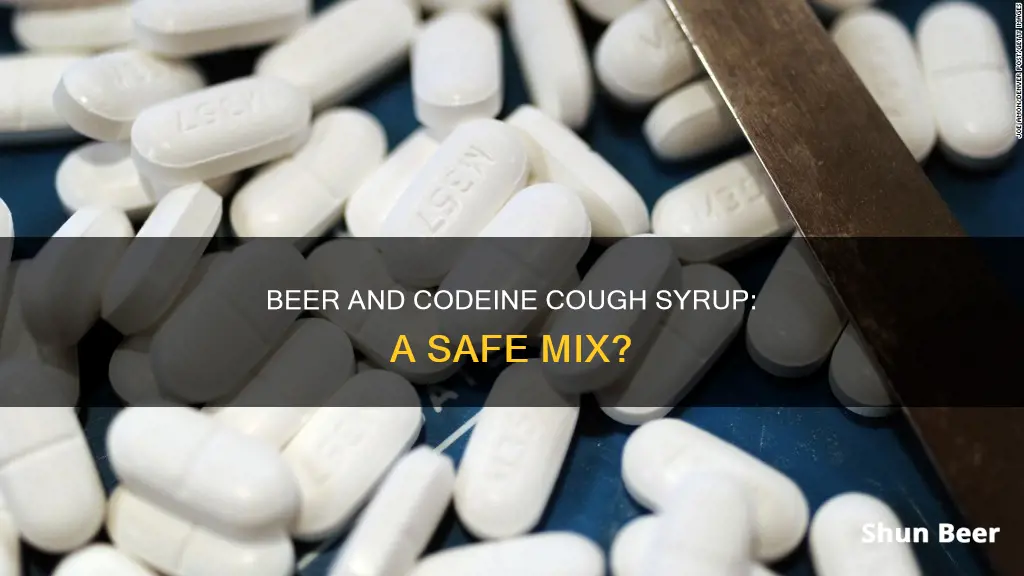
Codeine is a prescription opioid painkiller and cough suppressant that is used to reduce coughing and treat mild to moderate pain. It is available in the form of a capsule, tablet, or liquid and can be purchased with or without a prescription. Codeine is often misused, especially when mixed with alcohol, as the combination of the two substances can lead to a more intense high. This practice, however, can be extremely dangerous and even deadly. Both codeine and alcohol are central nervous system depressants, and when combined, they can cause a variety of negative side effects such as drowsiness, dizziness, impaired judgment, and difficulty breathing. More severe consequences include respiratory distress, permanent organ damage, coma, and even death. It is, therefore, crucial to avoid mixing codeine and alcohol to prevent serious health risks and potential overdose.
| Characteristics | Values |
|---|---|
| Should you drink a beer while taking codeine cough syrup? | No |
| Why? | The combination of codeine and alcohol can lead to several adverse health effects, including liver damage, nausea, vomiting, dizziness, poor motor function, impaired cognitive functions, trouble concentrating, irregular heartbeat, shallow breathing, permanent organ damage, and even death |
| How long should you wait after taking codeine before drinking alcohol? | It takes around half a day for codeine to be out of your system, but it is recommended to wait at least 24 hours before consuming alcohol. |
What You'll Learn

The dangers of mixing codeine and alcohol
Mixing codeine and alcohol is extremely dangerous and can lead to a host of adverse mental and physical effects, including the risk of overdose and death. Both substances are central nervous system depressants, which means they cause relaxation, sleepiness, and a euphoric feeling. When combined, the effects of each become more pronounced, enhancing the intoxication and leading to dangerous side effects.
One of the most significant dangers of mixing codeine and alcohol is the increased risk of respiratory depression, which can cause irregular breathing and reduce the amount of oxygen reaching the brain and body. This deprivation of oxygen can result in long-term damage to major organs and even death. Additionally, the combination can lead to severe drowsiness or fatigue, delayed motor skills and reaction time, fainting, coma, and gastrointestinal issues such as abdominal bloating, inflammation, ulcers, indigestion, and malnutrition.
The mixture of codeine and alcohol can also impair judgment, making activities such as driving extremely risky. It can also increase the risk of addiction, as the enhanced effects can lead to cravings and a higher tolerance for the substances. Furthermore, mixing codeine and alcohol can make it harder to treat an overdose, as Naloxone alone may not be sufficient, and immediate medical attention, including stomach pumping, may be required.
Beer and Bears: A Dangerous Mix?
You may want to see also

Side effects of mixing codeine and alcohol
Mixing codeine and alcohol is extremely dangerous and can lead to a range of adverse side effects. Both substances are central nervous system (CNS) depressants, and when combined, they intensify each other's effects, increasing the risk of overdose and long-term health damage. Here are some detailed paragraphs on the side effects of mixing codeine and alcohol:
Enhanced Sedation and Drowsiness:
The combination of codeine and alcohol enhances feelings of sedation and drowsiness, resulting in a more pronounced calming effect. Users may experience overwhelming tiredness, impaired alertness, and difficulty staying awake. This increased sedation can impair motor skills and reaction time, making tasks requiring coordination, such as driving, more hazardous.
Cognitive Dysfunction:
Mixing codeine and alcohol can lead to cognitive dysfunction, including difficulty concentrating and compromised decision-making abilities. Users may experience challenges in maintaining mental clarity and focus, which can further increase the risk of accidents.
Gastrointestinal Issues:
The combination of codeine and alcohol can irritate the stomach, leading to nausea and vomiting. It can also contribute to dehydration and electrolyte imbalances. Additionally, both substances can cause memory deficits when combined, making it difficult for users to recall events during the period of intoxication.
Respiratory Depression:
One of the most dangerous and potentially life-threatening effects of mixing codeine and alcohol is severe respiratory depression. Both substances depress the central nervous system, slowing down vital functions such as breathing and heart rate. Respiratory depression can lead to irregular breathing, reducing the amount of oxygen reaching the brain and body. This deprivation of oxygen can result in long-term damage to major organ systems and even death.
Increased Risk of Overdose:
Mixing codeine and alcohol increases the risk of overdose. The enhanced intoxication resulting from the combination can make it easier for users to accidentally take a fatal dose. Additionally, in the case of an overdose, the presence of alcohol makes it harder to treat, as naloxone alone may not be sufficient to reverse the overdose.
Long-Term Health Damage:
Chronic misuse of codeine and alcohol can lead to long-term health consequences, including liver damage, gastrointestinal issues, and addiction. Continued use can lead to tolerance, requiring higher doses to achieve the same effects, further increasing the risk of a fatal overdose.
Beer: A Friend or Foe for Passing Kidney Stones?
You may want to see also

Why people mix codeine and alcohol
Mixing codeine and alcohol is extremely dangerous and can lead to a host of adverse mental and physical effects. Despite this, it has become an increasingly popular trend, especially among young people, as it increases the level of intoxication a person experiences.
Codeine is a prescription opioid painkiller and cough suppressant that increases a person's tolerance to pain. It is only available by prescription and is meant to be consumed in low doses. When used correctly, it can help patients suffering from cold-related pain and/or chronic disruptive coughing find relief. However, when misused or combined with other substances like alcohol, it can lead to dangerous consequences.
Taking codeine without a prescription or in any way that is not directed by a doctor is considered abuse. This includes taking larger doses than prescribed and mixing the drug with other substances to get a stronger effect. The main reason people abuse codeine is because of the euphoric high that the drug produces. Codeine is habit-forming and quite easy to become addicted to. The intense high can cause people to crave the drug past the point of what is prescribed and develop a higher tolerance, requiring larger doses.
Many people who misuse codeine may then begin combining the drug with alcohol to intensify their high. This does increase the level of intoxication, but it also increases the risk of overdose, which can be fatal. Despite the potentially dangerous consequences, many people continue to mix codeine and alcohol to enhance the effects.
The mixture of codeine and alcohol intensifies the effects of both substances, increasing the risk of overdose and long-term health damage. Alcohol can cause narcotic pain relievers like codeine to be rapidly released into the system, resulting in dangerously high blood levels and intoxication. The combination can also result in extremely impaired judgment, making driving and other daily activities particularly risky. Some of the most harmful side effects of mixing the two substances include extreme drowsiness, delayed motor skills and reaction time, respiratory depression, fainting, coma, and even death.
One of the most dangerous and potentially life-threatening effects of mixing alcohol and codeine is severe respiratory depression, which can cause irregular breathing and reduce the amount of oxygen reaching the brain and body. This deprivation of oxygen can lead to long-term damage to major organ systems and even death. Additionally, abusing alcohol and codeine together increases the risk of liver and kidney damage, as well as gastrointestinal issues such as abdominal bloating, inflammation, ulcers, indigestion, and malnutrition.
Beer and Indomethacin: Is It Safe to Drink?
You may want to see also

How long to wait after taking codeine before drinking alcohol
Mixing codeine and alcohol is extremely dangerous and can lead to a host of adverse mental and physical effects. Both substances are central nervous system depressants, which means they cause relaxation, sleepiness, and a euphoric feeling. When combined, codeine and alcohol intensify the effects of one another, increasing the risk of overdose, respiratory depression, and even death.
Because of the potential for negative interactions, codeine and alcohol should never be taken together. If you have taken a dose of codeine, it is recommended to wait at least 15 hours before consuming alcohol. This is because, although the effects of codeine wear off in four to six hours, the drug itself can stay in your system for much longer. The half-life of codeine, or the time it takes for half of the drug to leave your system, is three hours. Since it generally takes five half-lives for a drug to completely leave your system, this means codeine can still be present in your body for up to 15 hours after taking a dose.
It is important to note that the liver can only process about one drink per hour, but this rate can vary, making it difficult to determine exactly when it is safe to drink alcohol after taking codeine. To be safe, it is best to wait at least 15 hours after taking codeine before consuming alcohol.
Combining codeine and alcohol can lead to a range of dangerous side effects, including:
- Extreme drowsiness or fatigue
- Delayed motor skills and reaction time
- Impaired judgment and thinking
- Respiratory depression
- Fainting, coma, and even death
It is worth mentioning that the risk of overdose increases when codeine and alcohol are mixed. In the case of an overdose, the opioid reversal agent naloxone (Narcan) can be administered to temporarily stop the overdose symptoms. However, when alcohol is involved, naloxone alone may not be sufficient, and immediate medical attention is required.
Beer and Fever: Is There a Link?
You may want to see also

Treatment for codeine and alcohol addiction
Mixing codeine and alcohol is extremely dangerous and can lead to a host of adverse effects, including an increased risk of overdose and long-term health damage. Therefore, it is crucial to seek professional help if you or someone you know is struggling with codeine and alcohol addiction.
The first step towards recovery is recognizing the problem and seeking professional help. Treatment for codeine and alcohol addiction typically involves a combination of detoxification, behavioural therapy, and ongoing support. Here are some steps to consider:
- Detoxification: The first step in the treatment process is usually detoxification, which involves safely removing codeine and alcohol from the body under medical supervision. This process can be challenging due to withdrawal symptoms, so it is essential to seek professional help.
- Behavioural Therapy: After detoxification, behavioural therapy can help address the underlying causes of addiction and develop healthy coping mechanisms. Cognitive-behavioural therapy (CBT) is a common approach that helps individuals identify and change negative thought patterns and behaviours.
- Support Groups: Support groups, such as 12-step programs, can provide ongoing support and accountability during recovery. These groups offer a safe space to share experiences and connect with others going through similar struggles.
- Inpatient or Outpatient Rehabilitation: Depending on the severity of the addiction and the presence of any co-occurring mental health disorders, inpatient or outpatient rehabilitation programs may be recommended. These programs provide intensive treatment and support in a structured environment.
- Medication-Assisted Treatment (MAT): In some cases, medication may be used to help manage withdrawal symptoms and reduce cravings. It is important to note that MAT should be used under the supervision of a medical professional.
- Ongoing Support and Aftercare: Recovery is a lifelong journey, and ongoing support is crucial to maintain sobriety. This may include regular attendance at support group meetings, individual therapy, or participation in sober living communities.
Resources for Help
If you or someone you know is struggling with codeine and alcohol addiction, there are resources available to help:
- SAMHSA's National Helpline: 1-800-662-HELP (4357) - A free, confidential, 24/7 treatment referral and information service in the United States.
- Alcohol Rehab Guide: (877) 624-1853 - A paid service that connects individuals with treatment providers for alcohol and drug addiction.
- National Alcohol and Other Drug Hotline (Australia): 1800 250 015 - A free and confidential advice, information, and counselling service about alcohol and other drugs.
Rotten Beer: Is It Safe to Drink?
You may want to see also







